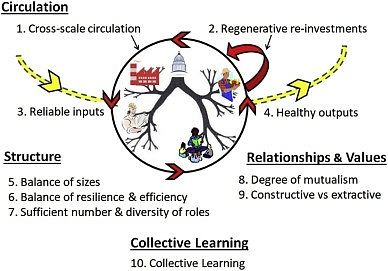The question: How can you measure the regenerative potential of a city?
A regenerative economy is a circular economic system that aims for a balanced and sustainable relationship between human beings and the larger planetary ecosystem.
Regenerative economics and –economies are being studied from multiple perspectives, but ecology or energy network science, which tracks the circulation of resources and the effect of indirect flows, has shown promise as a quantitative measure.
Regenerative economics proposes ten principles, grouped into four categories (see slide): circulation; structure; relationships & values; and collective learning. This project focuses on the 6th principle, the balance between resilience and efficiency. Too resilient, and the ecosystem stagnates. Too efficient, and the system proves to be brittle. Natural systems find a balance between these two extremes. So, although it might be expected that, by becoming more circular, a system also becomes more resilient, this is not the case. The researchers took the EU's measure of resilience and adjusted two variables – the recycling rate and the export rate – to see how network properties changed. They found that maximum theoretical robustness happens somewhere around 30-40%, lower even than seen in natural ecosystems.
To test the sixth and four more of the principles in practice the researchers turned to the Greek island of Samothraki, comparing current data with that collected and analyzed 90 years ago. This showed that, over that period, the island had become import based and non-circular, considerably increasing domestic material consumption and the production of solid waste.
The research shows that these five principles can successfully be monitored by indicators and therefore can be applied to other cases with ecosystem of interconnected networks, such as cities. But it will require systematic and extensive data collection, more research, and a move away from a mindset geared towards efficiency (i.e. return on investment).
Measuring regenerative economics: 10 principles and measures undergirding systemic economic health, Fig. 3, Fath et al., Global Transitions, Volume 1, 2019, Pages 15-27
